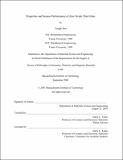Properties and sensor performance of zinc oxide thin films
Author(s)
Min, Yongki, 1965-
DownloadFull printable version (5.063Mb)
Other Contributors
Massachusetts Institute of Technology. Dept. of Materials Science and Engineering.
Advisor
Harry L. Tuller.
Terms of use
Metadata
Show full item recordAbstract
Reactively sputtered ZnO thin film gas sensors were fabricated onto Si wafers. The atmosphere dependent electrical response of the ZnO micro arrays was examined. The effects of processing conditions on the properties and sensor performance of ZnO films were investigated. Using AFM, SEM, XRD and WDS, the 02/Ar ratios during sputtering and Al dopant were found to control the property of ZnO films. Subsequent annealing at 700 C improved the sensor response of the films considerably although it had only minor effects on the microstructure. DC resistance, I-V curves and AC impedance were utilized to investigate the gas response of ZnO sensors. ZnO films prepared with high O2/Ar ratios showed better sensitivity to various gases, a feature believed to be related to their lower carrier density. Al doped ZnO showed measurable sensitivity even with lower resistance attributable to their porous microstructure. AC impedance identified two major components of the total resistance including Schottky barriers at the Pt-ZnO interfaces and a DC bias induced constriction resistance within the ZnO films. Time dependent drift in resistance of ZnO films has been observed. Without applied bias, the ZnO films showed a fast and a slow resistance change response when exposed to gases with varying oxygen partial pressure with both response components dependent on operating temperature. Even at the relatively low operating temperatures of these thin film sensors, bulk diffusion cannot be discounted. The oxygen partial pressure dependence of the sensor resistance and its corresponding activation energy were related to defect process controlling the reduction/oxidation behavior of the ZnO. (cont.) In this study, time dependent DC bias effects on resistance drift were first discovered and characterized. The DC bias creates particularly high electric fields in these micro devices given that the spacing of the interdigited electrodes falls in the range of microns. The high electric field is believed to initiate ion migration and/or modulate grain boundary barrier heights, inducing resistance drift with time. Such DC bias resistance induced drift is expected to contribute to the instability of thin film micro array sensors designed for practical applications. Suggestions for stabilizing sensor response are provided.
Description
Thesis (Ph.D.)--Massachusetts Institute of Technology, Dept. of Materials Science and Engineering, 2003. Includes bibliographical references (p. 144-152). This electronic version was submitted by the student author. The certified thesis is available in the Institute Archives and Special Collections.
Date issued
2003Department
Massachusetts Institute of Technology. Department of Materials Science and EngineeringPublisher
Massachusetts Institute of Technology
Keywords
Materials Science and Engineering.